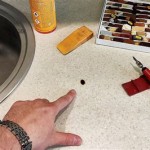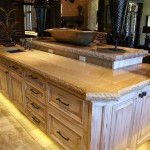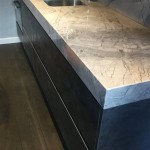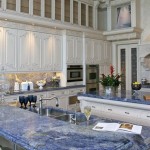John Boos Butcher Block Countertops: A Deep Dive into Quality and Craftsmanship
John Boos butcher block countertops have become synonymous with quality, durability, and aesthetic appeal in both residential and commercial kitchens. For over a century, the company has maintained a commitment to crafting exceptional butcher blocks, earning a reputation for excellence that few competitors can match. Understanding the materials, construction techniques, and maintenance requirements of these countertops is essential for anyone considering incorporating them into their design.
This article delves into the various aspects of John Boos butcher block countertops, examining their construction, wood types, applications, and the care they require to maintain their beauty and functionality for years to come. By understanding these factors, consumers can make informed decisions about whether a John Boos butcher block is the right choice for their space.
The Rich History and Legacy of John Boos & Co.
The story of John Boos & Co. began in 1887 in Effingham, Illinois. John Boos, Sr., a local blacksmith, created a sturdy wooden cutting board for a local butcher, Conrad Boos. The cutting board, made from a sycamore tree, proved exceptionally durable and quickly gained popularity among local butchers. Recognizing the demand for such a product, John Boos, Sr. and his son, John Boos, Jr., established a company dedicated to producing high-quality butcher blocks.
Throughout the 20th century, John Boos & Co. expanded its product line while maintaining its commitment to craftsmanship. The company’s butcher blocks became a staple in commercial kitchens across the United States. Over time, home cooks and designers also began to recognize the value and beauty of these durable surfaces, leading to their increased popularity in residential settings. The company’s dedication to quality and its long-standing history have contributed significantly to the brand’s enduring reputation.
Today, John Boos & Co. remains a family-owned business, upholding the traditions and standards established by its founders. The company's products are known for their exceptional quality, durability, and craftsmanship, making them a preferred choice for professional chefs and discerning homeowners alike.
Understanding the Construction and Wood Types
The construction of a John Boos butcher block countertop is a meticulous process that combines time-honored techniques with modern technology. The result is a product that is both beautiful and exceptionally durable. There are three primary construction styles: edge grain, end grain, and blended grain. Each style offers a unique aesthetic and varying levels of durability.
Edge Grain: Edge grain butcher blocks are constructed with long, narrow pieces of wood that are glued together with the edges facing up. This construction style is known for its durability and affordability. Edge grain provides a smooth, continuous surface that is ideal for general food preparation.
End Grain: End grain butcher blocks are constructed with the ends of the wood pieces facing up, creating a checkerboard-like pattern. This construction style is considered the most durable as the wood fibers absorb knife impacts, minimizing wear and tear. End grain is also gentler on knives, helping to maintain their sharpness. Due to the complex construction process and the use of more wood, end grain butcher blocks are typically more expensive than edge grain blocks.
Blended Grain: Blended grain butcher blocks combine elements of both edge and end grain construction. This style offers a unique aesthetic and a balance between durability and cost. The specific arrangement of the wood pieces can vary, allowing for a range of design options.
The choice of wood species is also crucial to the quality and appearance of a John Boos butcher block countertop. The company offers a variety of wood options, each with its own unique characteristics:
Hard Maple: Hard maple is the most popular choice for butcher block countertops due to its hardness, durability, and tight grain pattern. Its light color and neutral tone make it a versatile option that complements a wide range of kitchen designs.
Walnut: Walnut is a premium hardwood known for its rich, dark color and distinctive grain patterns. Walnut butcher blocks add a touch of elegance and sophistication to any kitchen. While slightly softer than hard maple, walnut is still a durable and long-lasting option.
Cherry: Cherry wood is prized for its warm, reddish-brown hue and smooth, even grain. Cherry butcher blocks offer a classic and timeless look. Like walnut, cherry is slightly softer than hard maple but still provides excellent durability for food preparation.
Red Oak: Red Oak is a hardwood known for its reddish-brown color and distinctive grain patterns. Red Oak butcher blocks can offer a distinctive and rustic appearance. However, Red Oak is more porous than maple, walnut, or cherry, and requires more careful sealing and maintenance.
The selection of wood species and construction style should be based on individual preferences, budget, and intended use. Consider the aesthetic you are trying to achieve and the level of durability you require when making your decision.
Applications and Design Considerations
John Boos butcher block countertops are incredibly versatile and can be used in a variety of applications throughout the kitchen and beyond. Their natural beauty and durability make them a desirable addition to any space. When integrating them into your design, consider the specific needs and aesthetics of the area.
Kitchen Countertops: This is perhaps the most common application for John Boos butcher blocks. They provide a durable and attractive surface for food preparation, serving, and general kitchen tasks. Butcher blocks can be used for entire countertops, islands, or as accent pieces in conjunction with other materials like granite or marble.
Kitchen Islands: A butcher block island adds a functional and stylish focal point to the kitchen. The island can serve as a dedicated food preparation area, a casual dining space, or a gathering spot for family and friends. The butcher block surface provides ample workspace and a warm, inviting feel.
Workstations: Smaller butcher block sections can be incorporated into workstations for specific tasks, such as baking or preparing charcuterie boards. These workstations can be freestanding or integrated into existing cabinetry.
Bar Tops: Butcher block bar tops offer a warm and inviting surface for entertaining. The natural wood grain adds character and charm to the bar area, creating a welcoming atmosphere.
Desks and Tables: Beyond the kitchen, John Boos butcher blocks can be used to create unique and stylish desks and tables. The durable surface is ideal for writing, crafting, or simply adding a touch of natural beauty to any room.
When designing with John Boos butcher blocks, consider the overall style of the space. The natural wood grain complements a variety of design aesthetics, from rustic and farmhouse to modern and contemporary. The wood can be stained or finished to match existing cabinetry or flooring. The thickness of the butcher block should also be considered. Thicker butcher blocks provide greater durability and a more substantial feel.
Integrating a sink or cooktop into a butcher block countertop requires careful planning and execution. Consult with a professional fabricator to ensure that the cuts are precise and that the edges are properly sealed to prevent water damage. Consider the placement of outlets and other utilities to ensure a functional and aesthetically pleasing design.
Maintaining and Caring for Your Butcher Block
Proper maintenance is essential to preserving the beauty and longevity of a John Boos butcher block countertop. While butcher blocks are known for their durability, they are susceptible to damage from water, heat, and improper cleaning. Following a few simple guidelines will help keep your butcher block looking its best for years to come.
Oiling: Regular oiling is the most important aspect of butcher block maintenance. The oil helps to prevent the wood from drying out, cracking, and absorbing moisture. Food-grade mineral oil or a specially formulated butcher block oil should be applied every few weeks, or more frequently if the butcher block is used heavily. To oil the butcher block, apply a generous amount of oil to the surface and allow it to soak in for several hours, or overnight. Wipe off any excess oil with a clean cloth.
Cleaning: Clean your butcher block countertop after each use with warm, soapy water. Avoid using harsh chemicals, abrasives, or bleach, as these can damage the wood. A mild dish soap is typically sufficient for removing food residue and stains. Sanitize the butcher block occasionally with a solution of white vinegar and water. This will help to kill bacteria and prevent odors.
Sealing: While oiling helps to protect the wood from moisture, sealing provides an additional layer of protection. Butcher block sealers are typically made from a combination of mineral oil and beeswax. The sealer helps to create a water-resistant barrier that prevents liquids from penetrating the wood. Apply the sealer according to the manufacturer’s instructions.
Protecting from Heat: Always use trivets or hot pads to protect your butcher block from hot pots and pans. Direct heat can scorch or warp the wood.
Preventing Water Damage: Wipe up spills immediately to prevent water from soaking into the wood. Avoid leaving wet items, such as sponges or dishcloths, on the butcher block surface for extended periods of time.
Sanding and Refinishing: Over time, your butcher block countertop may develop scratches, dents, or stains. These imperfections can be removed by sanding the surface and refinishing it. Use a fine-grit sandpaper to gently sand the affected areas. After sanding, apply a new coat of oil or sealer to protect the wood.
By following these maintenance guidelines, you can ensure that your John Boos butcher block countertop remains a beautiful and functional part of your kitchen for many years to come.
Cost Considerations and Value Proposition
Investing in a John Boos butcher block countertop represents a significant financial commitment, but one that offers considerable long-term value. Understanding the factors that influence the cost is essential for budgeting and making informed purchasing decisions.
The price of a John Boos butcher block countertop varies depending on several factors, including:
Wood Species: Premium hardwoods like walnut and cherry typically cost more than hard maple.
Construction Style: End grain butcher blocks are generally more expensive than edge grain blocks due to the more complex construction process and the greater amount of wood required.
Size and Thickness: Larger and thicker butcher blocks will naturally cost more due to the increased material usage.
Finishing: Custom finishes, such as staining or special sealers, can add to the overall cost.
Installation: Professional installation will incur additional costs, but it is recommended to ensure proper fitting and sealing.
While the initial investment may be higher than other countertop materials, John Boos butcher blocks offer several compelling advantages that contribute to their long-term value:
Durability: With proper care, a John Boos butcher block countertop can last for decades. The wood is resistant to scratches, dents, and other forms of damage.
Functionality: The surface is ideal for food preparation and provides a comfortable and hygienic workspace.
Aesthetic Appeal: The natural beauty of the wood adds warmth and character to any kitchen. The butcher block countertop can be customized to match a variety of design styles.
Resale Value: A well-maintained John Boos butcher block countertop can increase the resale value of your home. It is a desirable feature that appeals to many potential buyers.
When evaluating the cost of a John Boos butcher block countertop, consider the long-term benefits and the value it brings to your home. While it may be a more expensive option upfront, its durability, functionality, and aesthetic appeal make it a worthwhile investment.

Aa Maple Butcher Block With 16 Thick End Grain Top John Boos

Aa Maple Butcher Block With 16 Thick End Grain Top John Boos

John Boos Walkct4227 O Island Countertop 42 W X 27 D 1 2 Thick Butcher Block Construction Oil Finish

Refresh Your Kitchen Ahead Of The Holidays With Butcher Block Countertops John Boos

John Boos Butcher Block Counter Top 1½ In X 42 25 Maple

John Boos Bbit2425 Island Countertop 24 W X 25 D 4 Thick End Grain Hard Rock Maple

John Boos Butcher Block Kitchen Countertop 24 X 25 1 2 Cherry

Aa Maple Butcher Block With 16 Thick End Grain Top John Boos

John Boos Maple Kitchen Countertop 48 Wide 1 75 Thick

John Boos Butcher Block Review Pros Kitchens Youtube
See Also








